Galax GeForce GTX 1080 Ti Hall of Fame Review
Why you can trust Tom's Hardware
Power Consumption
Naturally, the default power target of 275W is used in full during gaming workloads and our stress test. Increasing this target using MSI's Afterburner Extreme software to the feasible maximum of about 350W is more than sufficient, so long as you don't get too unlucky in the silicon lottery.
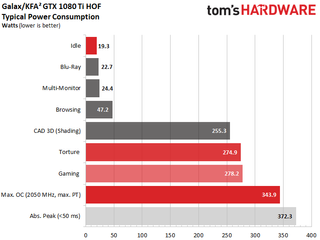
The chip on our test sample isn't the best, but it's good enough to reach just about 1947 MHz at 1.05V, provided the card stays under 50°C. Out of the box, and below 65°C, 1936 MHz is still achievable at 1.05V.
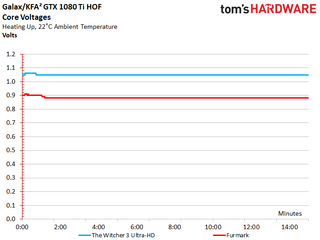
Gaming Loop
Let's break the power consumption measurement into separate, higher-resolution lines for each supply rail over a two-minute interval. In spite of our intelligent low-pass filter, occasional spikes remain visible. In places, they reach up to 330W without overclocking. On average, however, this card exceeds its 275W power target by only 3W.
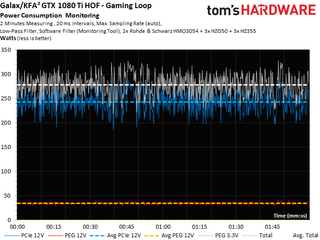
The graph corresponding to our current measurement looks just as hectic.
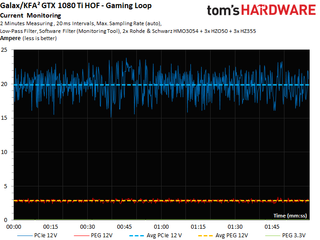
Torture Test
Faced with a more consistent load, power consumption does rise a little. However, the peaks are almost completely eliminated. Instead, we see where GPU Boost kicks in to start limiting power use. On average, this ensures that the card hits the designated power target almost spot on.
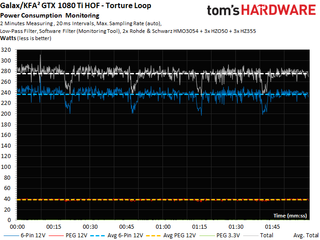
The isolated current readings behave similarly.
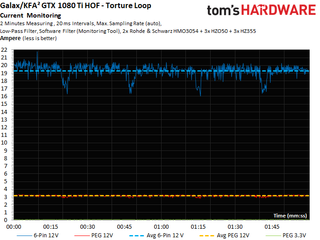
Load On The Motherboard Slot
Ever since the launch of AMD's Radeon RX 480, we've been asked to include this metric in our reviews. But Galax's GeForce GTX 1080 Ti HoF gives us no reason to be concerned about load on the motherboard's 16-lane PCIe 3.0 slot. In fact, our highest reading is just over 3A, leaving plenty of headroom under the PCI-SIG's 5.5A ceiling.
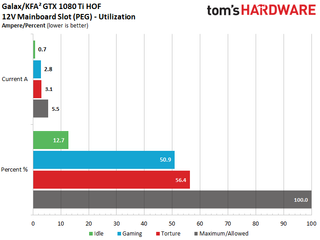
MORE: Best Graphics Cards
MORE: Desktop GPU Performance Hierarchy Table
MORE: All Graphics Content
Current page: Power Consumption
Prev Page Gaming Performance Next Page Clock Rates, Overclocking & HeatStay on the Cutting Edge
Join the experts who read Tom's Hardware for the inside track on enthusiast PC tech news — and have for over 25 years. We'll send breaking news and in-depth reviews of CPUs, GPUs, AI, maker hardware and more straight to your inbox.
-
JonDol "What's more, the card is only available through Galax's website (at almost Titan Xp pricing, no less)"Reply
And yet I'd buy this one rather than the Xp: while I have no problems with Titan's price I do have a big problem with its noise and cooling and for this reason I think that Nvidia's decision to not open the Titan to OEMs (and their better custom cooling solutions) was a really bad one. -
AndrewJacksonZA This thing is simply beautiful... I would love to have one. :-)Reply
Thank you for the review, Igor! -
10tacle Whew what a beast! As much as I like the white theme as my next build will be white with blue LEDs, I could never justify paying this premium over my $730 EVGA SC2 Gaming 1080 Ti.Reply -
mac_angel for the GTX 1080ti cards, overclocking is better done by adjusting the curve in Afterburner instead of just adding +xx to the core clockReply -
FormatC Reply
Each card is unique and the curve may differ a lot. I use curves to undervolt my own cards, but this is in detail too much for such a review. The next reader will copy my curves and then bash me because it won't work for him. :)20099153 said:for the GTX 1080ti cards, overclocking is better done by adjusting the curve in Afterburner instead of just adding +xx to the core clock
-
Hal-Jordan I was curious how much they were charging for this. I don't see the price listed anywhere in the text of the article. There's a black "Suggested price..." box at the bottom of the page, with the price listed as "N/A," and the galax website appears to be offline. It seems that an important part of the review was omitted.Reply -
FormatC As we wrote the review, the card was available and the site online. Difficult to say, what happened.Reply -
redgarl Ugly as hell and the Achiles heel of the 1080s is the VRAM. Your card can die after a short time if the cooling solution is not adequate. i would not touch this with a 10 meter stick.Reply -
caustin582 Practical issues aside, Galax needs to fire whoever did the visual design for this card. My god is this thing ugly.Reply
